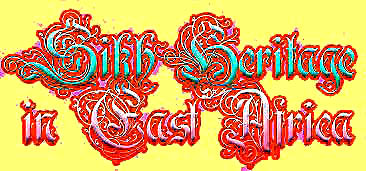
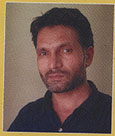
The
Sikhs in East Africa, particularly Kenya, are called 'Kalasinghas'! And thereby
hangs a tale.
When Sikhs were taken to East Africa in the 1890s as soldiers
to defend British interests, that is to police the Uganda Railway and hinterland
routes and subdue the Kabaka (Uganda) uprising and as indentured labour to build
railroad systems and open up Kenya's Masai land reserve to the outside world,
one Kala Singh (below)became a trailblazer.
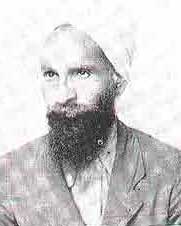
He
had come to Kenya from Patiala in 1886 at the age of sixteen. An adventurer, he
penetrated the Masai reserve and became famous as Kalasingha among the East Africans.
His
name stuck to the community. 'We love being addressed as Kalasinghas. The Sikhs
are respected for their contribution to their adopted country,' says Nairobi-based,
three-time Safari champion Joginder Singh.
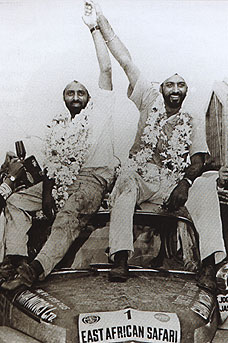
Joginder and Jaswant
For a long time, the Kenyan Public Transport
System carried a sticker, depicting the Sikhs as "Simba Wa Kenya"
which means the "Lions of Kenya".
In the first year of the
new millennium, there were approximately ten thousand Sikhs in Kenya, Uganda and
Tanzania.
However, a large number of them are leaving for the West and Australia
and New Zealand. 'Because of this exodus, the East African diaspora today is almost
half of what it was in the '70s. Most Sikhs, who run labour-oriented businesses,
are mainly concentrated in Nairobi in Kenya, Arusha in Tanzania and Kampala in
Uganda,' says businessman Amar Panesar of Nairobi. In 1970, there were about fifteen
thousand Sikhs in Nairobi alone. In 2002, there were just five thousand Sikhs
in the whole of Kenya.
However, the Namdhari Sikhs have grown in numbers since
1953 when Satguru Partap Singh visited Kenya. Their first gurdwara came up at
Ngara in Nairobi in 1956. Kenya officially hosted Satguru Jagjit Singh in 1962.
The
Namdharis, who by the '70s had grown into their biggest concentration outside
•India,
have made a significant contribution to the economic development of Kenya, including
the setting up of a large hospital at Gatundu.
There are twenty gurdwaras across
Kenya, including seven in Nairobi, seven across Tanzania and six across Uganda.
The Nairobi-based Khalsa School once taught Punjabi. Punjabi programmes are still
broadcast weekly, as is kirtan each morning on radio.
Makhan Singh, who spearheaded
the labour movement in Kenya, is credited with starting the Kenyan Worker
— in Punjabi and Urdu — in 1936. The paper folded up in the 1970s.
•However,
the Sikh Society still brings out Sikh Sandesh.
Tracing the growth of
the Sikh community, Panesar says there were about a hundred Sikhs in Nairobi in
1910. This community 'raised its first gurdwara within a year. 'At its
inauguration
in 1911, the Sikhs came from Mombasa, Nakuru, Kisumu and other towns.
Gurdwaras
and schools came up in various towns as more and more Sikhs trickled into
East
Africa,' according to the Nairobi Singh Sabha.
Thanks to Baba Puran Singh
(below), Kericho became the hub of community activities.
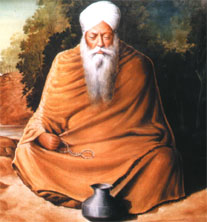
Having immigrated to Kenya in 1916, he set up the Guru Nanak Nishkam Sewak Jatha
to spread the universal message of Sikhism. A lover of nature, he built a garden
in the Town Centre in 1962 that was later re-named after him.
With a large
number of East African Sikhs immigrating to Britain, the Nishkam Sewak Jatha spread
its activities there, protesting Lord Denning's controversial judgment not to
recognize Sikhs as an ethnic group in 1982.
More than five thousand Sikhs held
a rally and petitioned Downing Street. The result: the Sikhs won and they were
defined as a racial group.
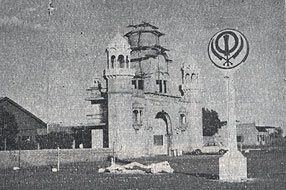
Makindu Gurdwara as in 1972
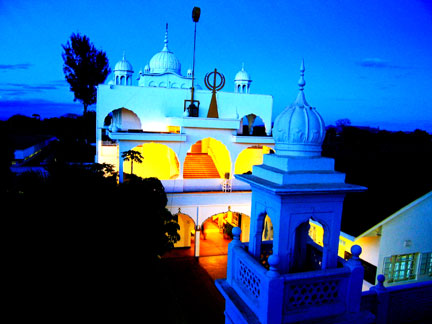
gurdwara in 2007
The gurdwara at Makindu on Mombasa
Road is the most visible symbol of the Sikh presence in East Africa. No one passes
by without partaking of langar.
In 1953, the Kenyan Sikhs got a huge plot of
land on Uyoma Street in Nairobi to build a new gurdwara whose foundation stone
was a landmark event in the history of the East African community.
'The
foundation stone was laid at an impressive ceremony on 16 January 1959 jointly
by Sardar Mohan Singh, Sardar Santokh Singh Mehta, Sardar Kartar Singh, Sardar
Jaswant Singh and Sardar Labh Singh (below). Sardar Santa Singh, the road
contractor, tarmacked the open space inside the gurdwara.

The building was completed in 1963 and opened by Sardar Inder Singh Gill on 1 November 1963. The flag was hoisted by Sardar Jodh Singh, retired chief inspector of police,' says the Singh Sabha. The tercentenary celebrations, V-300, under young Amarjit Singh, were another glorious event in the history of the community.
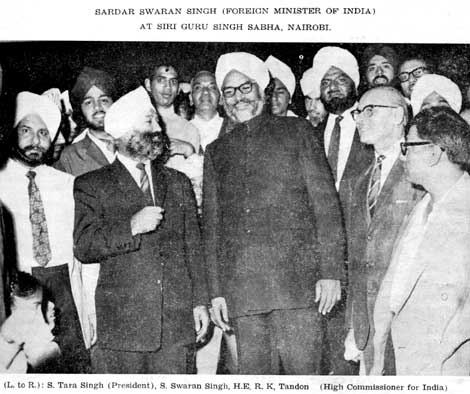
Apart
from Kala Singh, Makhan Singh, the Safari brothers, Justice Chanan Singh,& Kirpal
Singh Sagoo are other pioneers in East Africa.

Makhan
Singh is known as the father of the labour movement in Kenya. A visionary, he
once said, 'The main task before us is to forge a strong unity with Africans for
the common cause of democratic advance in this country. Learn the language of
the people — Swahili. Teach the best of your culture, learn the best from
African culture. This way lies our salvation and this is the way out.'
The
names of the Safari brothers — Joginder Singh and Jaswant Singh — will
always be written in golden letters in the history of East African Sikhs. Popularly
known as the Flying Sikhs and 'Simba Wa Kenya,' Joginder Singh (with his brother
Jaswant Singh) has become a legend in his own lifetime by winning the African
Safari thrice. Born in Nairobi, Joginder Singh says he was fascinated by speed
from his childhood. The young lad learnt the tricks of speed from his father,
Batan Singh, who owned garages in Kericho and Nairobi. Though he did not take
up motor racing till the age of 26, Joginder Singh went on to create new records.
He
took part in the gruelling rally twenty-two times and completed it nineteen times.
'My brother and I were the winners in 1965, 1974 and 1976,' he says with a broad
smile.
Amazingly, the two brothers won the 1965 safari in a self-prepared,
privately entered Volvo PV 544. 'Twice we finished second, once third, twice fourth
and thrice fifth,' he adds. In the process, the two brothers became the first
persons of non-European origin to win the World Championship Rally in 1965. Joginder
Singh added more "feathers to his turban" by winning the Kenya National
Rally Championship five times and the East African Rally Championship three times.
'In my entire life I won more than fifty times in Kenya, Uganda and Tanzania,
and achieved top places in rallies in Australia, the Ivory Coast, Greece, Sweden,
Ethiopia, Norway and Austria.'
For his accomplishments, Joginder Singh was
declared the "Motor Sportsman of the Year" in 1970 and 1976. He entered
the HALL OF FAME in 1995. 'Out of the ten nominations, I was the only Asian and
Sikh to be given this honour,' he says modestly.
Motor clubs around the world
have bestowed honours on the motorman who runs a spare parts company called Alpine
Auto Parts Ltd in Nairobi.
Narrating an interesting episode during the 1970
Safari, Amar Panesar says, 'A Sikh named Bhambra (Bikram Singh Bhamra)
was doing commentary on the event for an ethnic radio channel. When the Safari
brothers won, Bhambra was so overwhelmed that he lost his voice, threw away the
microphone and ran towards the two brothers. The Sikh community took the two brothers
on their shoulders to the city gurdwara.'
In hockey, the Nairobi Kenya Sikh
Union produced many players who donned the national colours at international meets.
Avtar Singh Sohal created a record by captaining the Kenyan team at many Olympics.
Many
Sikhs have played cricket for Kenya.
Kirpal Singh Sagoo was the first Sikh
to receive the Order of British Empire in this former British Colony.

The
octogenarian Sagoo (above), who now lives in Canada, was given the OBE
for his lasting contribution to educational, social, economic, religious, and
cultural spheres.
Justice Chanan Singh was the first Sikh to rise to the highest
position in the judiciary.
The Sikhs have done exceedingly well in the hotel
and tourism business. The Sarova Group, set up in 1974 and owned by the Vohra
family, is ranked as the second biggest hotel chain in Kenya. Managed by a third-generation
Sikh, Sandy Vohra, the Sarova Group owns seven hotels and resorts in East Africa.
In the year 2002, the Group, which employs more than 1,400 people, did business
worth 1.4 billion Kenyan shillings.
Sandy's father, G.S. Vohra, and his partner,
John Kariuki, kicked off the group by buying Ambassadeur Hotel on Moi Avenue in
Nairobi in 1974.
Two years later, the two partners acquired the twenty-two-acre,
340-room Whitesands Hotel on the north coast of Mombasa. The hotel offers the
best facilities in water sports in Kenya. The Stanley Hotel, which the group acquired
in 1978, is Nairobi's leading hotel.
The rise of the group coincided with the
tourist boom in Kenya in die 1980s. It opened a luxury tented camp called Sarova
Mara in the world renowned Masai Mara game reserve. The tents are spread along
two valleys to give one an authentic bush experience. Bush catering only adds
to the experience.
Apart from Sarova Mara, the group also owns the Sarova Lion
Hill in the heart of the Rift Valley in the Lake Nakuru National Park and the
Sarova Shaba Lodge in the Shaba Game Reserve.
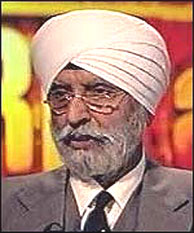
As
mentioned, a large number of Sikhs left East Africa after Kenya's independence
in 1962 and Idi Amin's crackdown in Uganda in 1972. Among those who made it big
in Britain, North America and elsewhere include Mota Singh (above)who
became the first Asian-Sikh judge in Britain and Dr Preetam Singh (below)
who became the first Sikh QC in Britain.
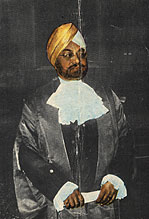
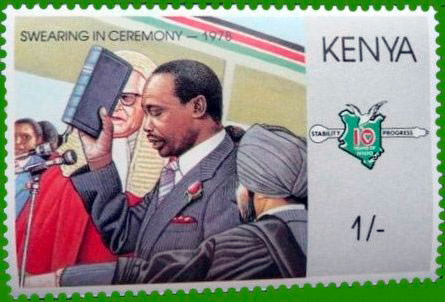
Kenya StampSh. 1/-:
In
the year 2000, Gurdev Singh Birdi became the first Sikh to hold a political office
in Kenya. He was elected ahead of thirty-six councillors to chair the Kilifi County
Council.
Birdi's father, Nand Singh, migrated to Kenya in 1939 and settled
in Nairobi's Parkland area. Birdi was born in 1949. Educated at Mbeheni Primary
School and Technical High School, Birdi spent three years doing a course in plumbing.
Today, he runs three companies — farms, construction and investments.
Nairobi's
Sukhbir is the badshah of Indipop. Born to a granthi who hailed from Jalandhar,
Sukhbir has mixed bhangra with rap, reggae, and African rhythms to create what
he calls New Srylee.
It was also the name of his first album released in 1994
in India, Africa and the Gulf. Its hit song Punjabi Munde Paun Bhangra made
Sukhbir a household name. 'It notched up record sales and I was nominated for
the Channel (V) Awards,' he says.
His next album Kurian Te Mundeyan Di Gal
Ban Gayee broke all records, topping the charts and earning him a platinum
disc. The next album Hai Energy, with its title songs Sauda Khara Khara also
did well.
Sukhbir began his career with kirtan. On the route to stardom, he
performed in nightclubs in Nairobi and Mombasa. Fluent in Swahili, English, Portuguese
and Spanish, the ponytailed Sukhbir says, 'I cater to diverse audiences through
my production company Dolphin.'
In the neighbouring Mauritius in the Indian
Ocean, many Sikhs came as indentured labour in the nineteenth century. Today,
there are hardly any. However, one name stands out: Jagdish Singh Koonjul who
has represented this beautiful island nation at the United Nations for years.
For the month of January in 2002, Mumbai-educated Koonjul was the president of
the UN Security Council.
'There is only one Sikh family in Port Louis who are
into the pharmaceutical business,' he says.
Tracing the roots of the family,
his wife, Manpreet, says her paternal great grandfather came to Mauritius from
Lucknow. 'But then the family line went missing. People move on in search of greener
pastures.' True. Very true.
A VERY SIGNIFICANT
EVENT HAPPENED IN THE HISTORY OF ASIANS, PARTICULARLY SIKHS, IN EAST AFRICA AND
THAT WAS THE ELECTION OF THE FIRST ASIAN DEPUTY MAYOR OF KENYA DURING THE COLONIAL
TIMES WHEN SUCH POSTS WERE RESERVED FOR EUROPEANS ONLY. THIS IS THE RISE OF SUCH
A MAN TO THE LEVELS OF NEAR STARDOM. THE PICTURES AND CUTTINGS FROM LOCAL AND
INTERNATIONAL PAPERS HAS BEEN SENT BY HIS SON, MEHARBAN SINGH JUTLLA FROM LONDON.
MY SINCERE THANKS TO HIM (KANWAL)
ALDERMAN MOHAN SINGH - THE FIRST ASIAN DEPUTY MAYOR OF COLONIAL KENYA
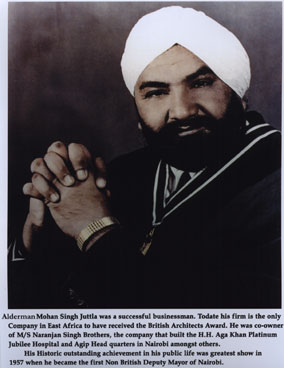
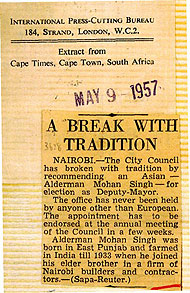
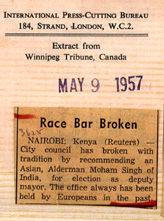
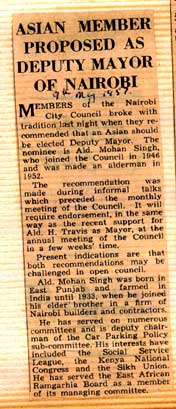
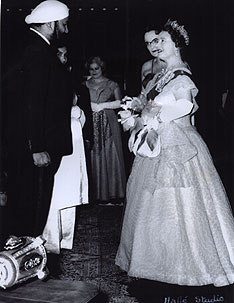
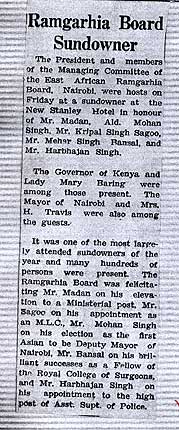
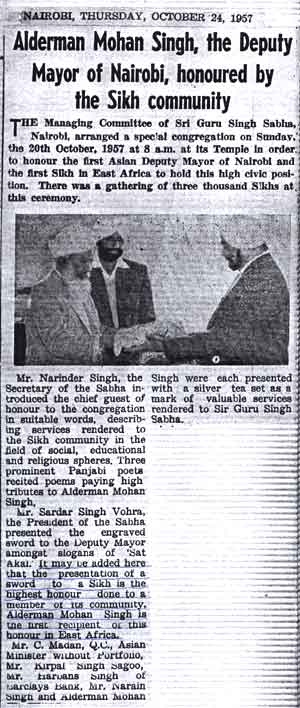
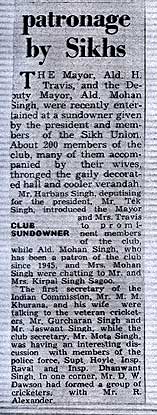
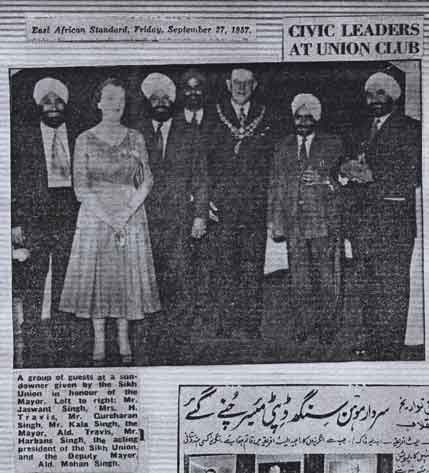
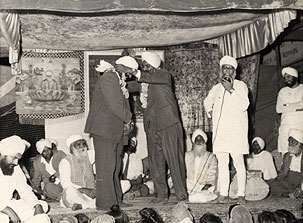
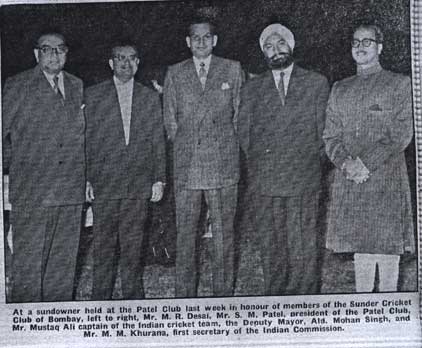
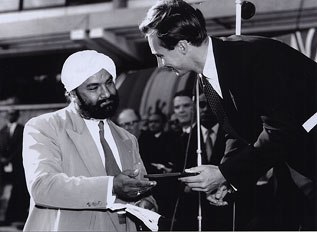
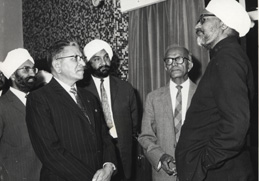

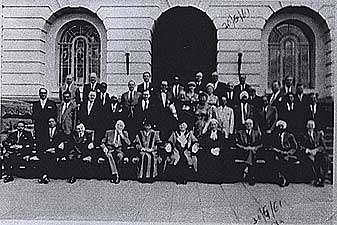
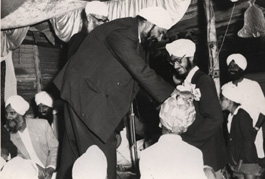
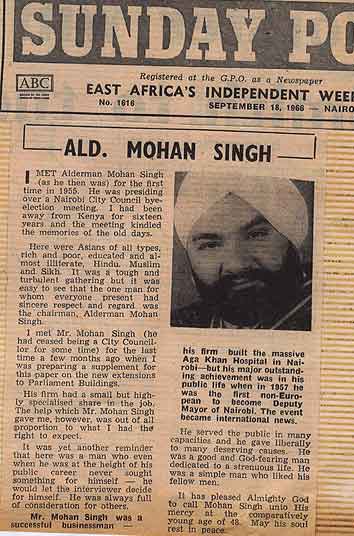
ARTICLE IN RAMGARHIA GAZETTE -THE FIRST DEPUTY MAYOR OF NAIROBI-S.MOHAN SINGH PASSES AWAY
The first Asian Deputy
Mayor of Nairobi, Mr. Mohan Singh, who died of heart attack in a local nursing
home on last Friday, the 9th September, l966, at 4-30 pm was born in Kang Araiyan,
dist. Jullundur, East Punjab in 1917. After schooling, he took to the traditional
family occupation of farming. He was born a farmer as well as an artizan.
His
three elders brothers were in Kenya and he was invited in 1933 to join them..
These four brothers formed a building contracting firm and well stood the economic
depression of 1931.
A
thanks giving congregation was held later in the evening at the Ramgarhia Hall,
Nairobi at which very high and befitting tributes were paid by Mr. Bakhshish Singh,
Mr. Phuman Singh Kanwal, Mr. Gurcharan Singh Gahir. Mr.Ajit Singh Madar, Gyani
Tara Singh Mauji, Mr. Balwant Singh Shant, Gyani Lal Singh and Mr. Parkash Singh
to Mr. Mohan Singh.
Further thanks giving congregations are being organised
by the local Sikh Temples during this week-end.
The Sikh Community has suffered
an irreparable loss by this untimely death. -The communal political tensions in
India between the all-India National Congress and the Muslim League have had severe
set back in Kenya, and impacts carried the leaders away. During this important
phase of political strife over here S. Mohan 'Singh stood as a candidate from
theEastleigh ward in a bye-election in 1946 His rival candidate was then a polished
shrewed social worker, Mr. Sadruddin, who commanded l600 Muslim votes against
combined 8,000 votes of Hindus and Sikhs. It was anybody's guess that Mr. Mohan
Singh would lose. But the Indian Leaders in Kenya were very much surprised to
hear the result of a very narrow majority of 3 votes won by Mr. Mohan Singh. This
victory was celebrated by Sikhs.
Mr. Mohan Singh's stars were on the ascending
again when he offered himself for the election of the Aldemanic Bench in 1952.
His rival candidate was the sitting member, Mr. Chunilal Kirparam, who had vast
experience of the City Council and was one of the senior most members of the council,
but on the other hand Mr. Mohan Singh had great drive and initiative to contest
the election. Once again the Indian community was surprised to learn that Mr.
Mohan Singh was elected to the Bench. The late Ald. Allah Dita Quereshi was the
chief supporter of Mr. Mohan Singh in this election.
During his terms of office
Mr.Mohan Singh served on various committees with dignity and maintained the reputation
well. He was very popular in all the committees. It. must be added here that he
along with his elder brothers formed the prominent building contractors firm of
Naranjan Singh Bros, in 1946. They built the Khalsa Boys and Girls School, Nairobi
and on the request of the Sri Guru Singh Sabha deducted a large sum of Shs. 50.000/-from
the original agreed amount.
Then he came in contact with the world over favours
Sikh divine —Sant Mani Singh —in Nairobi. This meeting proved very fruitful.
He as well as his other brothers bore the expenses of Saint Mani Singh while on
tours of East Africa. It is well known in Kenya and sincerely believed that the
prominence, fame, success in business and widespread acclaim of this family, and
especially the sucesses of Mr. Mohan Singh were due to well wishes of this divine,
His
firm built the Sikh Resting House, Mombasa. It built H. H. Aga Khan Platinum Jubilee
Hospital, Narobi and Agip Headquarters House. The Kenya Indian Congress had been
struggling for the past three decades against the Europeans for equal representations
on Municipal Council, Boards, Township and the Kenya Legislative Council, and
acceptance of Common roll without distinction of race, creed or colour. Many time
at the Nairobi City Council elections of Mayor, Deputy Mayor and committees the
Asian Councillors used to walk out as protest not accepting among them by the.
European councillors a candidate for the seat of a Deputy Mayor. These protestations
went on for years by the Asian councillors. At last a day arrived in 1957 when
Ald. Mohan Singh stood for the election of Deputy Mayor. His rival candidate was
a European. It was a hard f ight and again Mr. Mohan Singh was elected- This election
took place during the most difficult times of Emergency. The news was flashed
over the world. It was a great honour done to him.

He retired from the council in 1963 after serving it for 17 years. - The sad news of his demise was heard over the voice of Kenya all over East Africa. Sikh-religious leaders from Kenya, Uganda and Tanzania arrived in Nairobi to pay homage to him. His younger brother, Mr. Kala Singh; a partner of the Mombasa branch, Mr. Nand Singh, flew from India to attend the funeral. Also flew in, his son, Zail Singh, who is studying in U. K. in time. The funeral procession was one of the longest and crowded in history of Kenya. His body was carried to Namdhari Sangat, Ramgarhia Board, Sri Singh Sabha, Sri Gurdwara Bazar and Sri Gurdwara Ramgarhia Railway for prayers and robes of honour were offered by all these organizations. It is estimated that more than six thousand people of all races and communities attended the procession and the last cremation rites at the Hindu Crematorium on Sunday, the11th September.
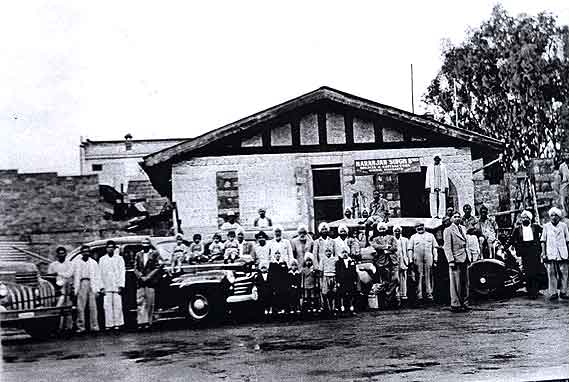

Family members of the Jutlla clan. From left to right sitting:Niranjan Singh (after whom the company Naranjan Singh Bros was named); Puran Singh (after whom a road was named as 'Puran Singh Close' - he died during the Mau Mau uprising); Hazara Singh; Alderman Mohan Singh; Standing on left yoinger brother Kala Singh. Photo around the 40/50's
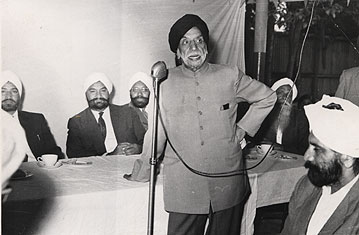
A party given to the Indian Parliament Speaker Hukam Singh when he visited Nairobi. From left can be seen Tarlok Singh Nandhra, Ald Mohan Singh, Harcharan Singh Sahota & Lal Singh
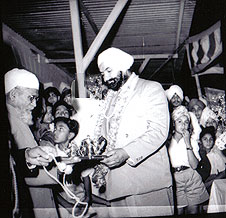
Alderman Mohan Singh being presented with a silver tea set by Suba Lal Singh of Namdhari Sangat Nairobi on his becoming the first Asian Deputy Mayor
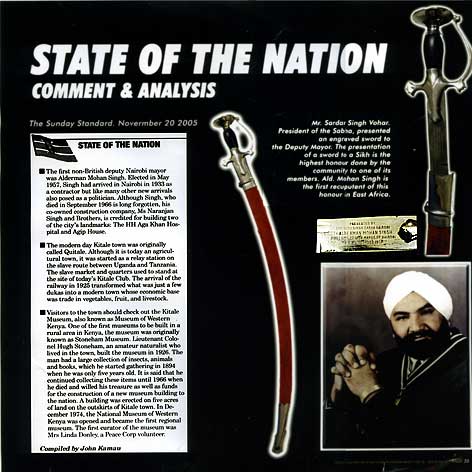

Whilst Ald. Mohan Singh achieved great heights in the Political and social world, his son Meharban took off as an adventurer - making his mark as an accomplished scout and a climber of mountains. A keen sportsman who plays golf regularly and was the golf captain of the Muthaiga Golf Club. Here we present an article by Narain Singh which appeared in the Illustrated Weekly of India.
 Meharban
receiving a shield from the governor of Kenya, Sir Evelyn Baring for achieving
prominence in the Scouts Open Cross Country in 1958.
Meharban
receiving a shield from the governor of Kenya, Sir Evelyn Baring for achieving
prominence in the Scouts Open Cross Country in 1958.
ILLUSTRATED WEEKLY OF INDIA
SCHOOL BOYS ON A CLIMBING EXPEDITION
Whatever other qualities the Asians
of Kenya and East Africa might have been credited with, the spirit to face danger
for its own sake has never been one of them. It will thus come both as a matter
of surprise and satisfaction for people in India to learn that within the community
there are such groups as the twelve Indian schoolboys of Nairobi who recently,
in the lace of parental objection and official disapproval, made the hazardous
climb of Mount Kenya to a point above 16,000 feet, :* highest reached by any Asian
so far.
The leader of the party was Satyapal Singh with Meharhan Singh. he
and Yez dir rustomji had previously climbed Mount Kilimanjaro. The nature of this
mountain, however, is such that reaching its summit is more of a test of endurance
than of the alpine-typo mountaineering. Yezdir was the only one who had also made
an assault on Mount Kenya- which presents the most formidable natural obstacles.
None of the others had mountaineering experience of any sort
When preliminary
arrangements were completed, the party approached the Mountain Club of Kenya with
a request for the necessary maps. Unwilling to take any responsibility for what
it considered a foolhardy project, the Club turned down the request and gave a
very firm warning of the dangers ahead.
But the boys went ahead regardless.
Their equipment was literally cut to the bone. Three members carried a total of
60lb. each, and the others 60 Ib. each. They had two tents. And they managed to
obtain a couple of maps which, however, could serve only a rudimentary purpose.
From
the nearest railway station of Naro Moru, the party walked uphill for two days
through the rain-drenched forest, till they reached the first huts which lie well
within the forest line. Here they spent the night.
Next morning,
they set off for the second hut. They could not reach it till It was dark, and
so decided to pass the night in one of the many caves on the way. After a day's
rest, they started for the base hut.
The boys soon' realised that it was necessary
to send one or two of the more experienced members in the party ahead to reconnoitre
the ground, Satyapal Singh and Meharban Singh accordingly, went along and, returning
later, were able to lead the party to Klarwill's hut.
- At this stage, one
of the boys' fell ill. It was decided to leave two members behind to look after
him while the others continued the climb. The next night was also passed in a
cave. There was no shelter for the night that followed, however. They had to camp
it out in the open, an ordeal from which some of the party showed serious after-effects
Having by now been joined by the three who had been left behind, they made their
way back to Klarwill's hut.
After a day's rest, it was agreed thai the party
should split into two groups— the first to climb Piggott Point, the other
to make the assault on Lenana Point
The first group of five was able to make
the ascent and return later in the day, but the second batch did not show up at
the base the whole night. It was found by a special search-party the next day.
After giving it the necessary directions for return to the base, the search-party
decided to make the Lenana Point climb by itself. As luck would have it, mist
and snow made the group lose its way while coming back. The boys had to spend
four entire days in a small cave, and eventually returned to the base, fatigued
and worn out.
OBJECTIVE ACHIEVED-
During the absence of the search-party,
Meharban Singh went off on his own and scaled the 17,000-ft,-high Nelion-the highest
peak reached by any member of the party. While descending from the long jutting
peak, he slipped and fell and received a nasty injury on his hand. But, before
returning, he tied his turban and scout badge on the summit of the peak.
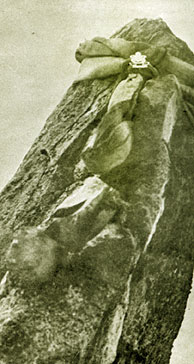
The Turban and Scout Badge of the conqueror can be seen on the 17000 ft. high Nelion Peak
Another accident occurred whose consequences
could have been really serious. Satyapal Singh, the leader, decided to indulge
in a bit of exploring on his own while the search-party was away. In doing so,
he sustained a fall of about 20 feet and became unconscious. When he came to,
he was unable to move and spent the night where he fell. It was not till late
next morning that he was able to rejoin his colleagues.
Eventually, all the
members of the party reached" Lenana Point, which is at a height of well
over 16,000 feet.
Thus ended an adventure without precedent for the Asians
of East Africa!
( Journalist Narain Singh was a very learned Sikh, living
in Nairobi, who wrote for many news papers and periodicals. This article written
by him was published in the Illustrated Weekly of India on November 29, 1959)
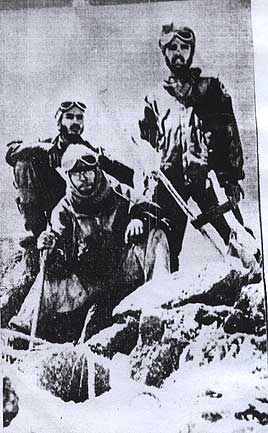
On Lenana Point -situated at a height of well over 16000 ft.
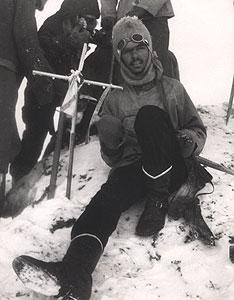
Mountaineer
Meharban on the "Kaiser Wilhelm Spitz" Height Point on Mt. Kilimanjaro
in 1958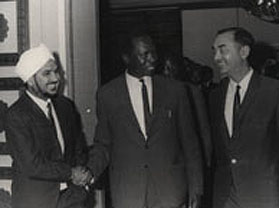
Meharban meeting the President of Kenya Mr. Moi and the Indian High Commissioner to kenya in 1968
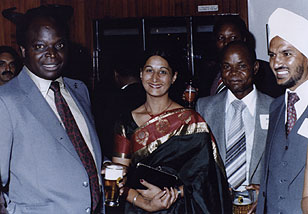
The Vice President of Kenya Mwai Kibaki and Ald I Lugonzo were invited to Vet. Lab Sports Club to open a Golf Tournament in 1997. Meharban (a life member of KANU) was the Golf Captain there who organised the tournament. His wife Baldev Kaur is seen in the middle.
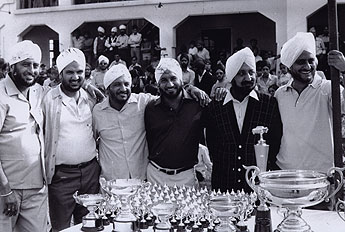
A car rally "Guru Nanak Rally"was held at the Sikh Union Club in honour of 'Puran Singh Jutlla of Naranjan Singh Bros and Channan Singh Ghattaura of General Workshop. Jack Simmonian won this rally and since then it has become a yearly event. The prizes were donated by Meharban Singh Jutlla and Charanjit Singh Ghattaura. In this picture taken in front of Sikh Union can be seen from left; Hardial Singh, Meharban Singh, Inderjit Singh, Mehnga Singh, Mohinder Singh Jandu and Avtar Singh Bassan
Another member of the Juttla family who is making her name as a very talented Silversmith, is the grand daughter of Ald. Mohan Singh and daughter of Meharban Singh. She is a very successful silversmith who has been exhibiting her work across the country and abroad. An article about her was printed in a local paper on March 2003.
WHY ASHI IS LEAVING HER CHILDREN BEHIND TO CHASE JEWEL OF A CHANCE IN OZ
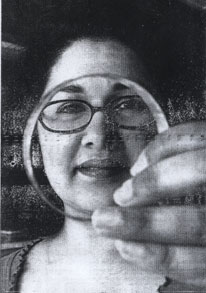
A
TALENTED jeweller is about to leave her husband and young children and fly to
the other side of the world - and they're delighted to see her go.
Silversmith
Ashi Marwaha is to spend three months perfecting her craft at a studio in Sydney,
Australia.
Mrs Marwaha (39), from Marton, near Gainsborough, has won a place
on the Here and There scheme, which enables British and Australian jewellers to
spend time in each other's countries.
She flies out on March 30 - five days
after her 40th birthday. Her trip Down Under is the second time she has been away
from her husband Gurdev (42), daughter Ravail (14) and son Prem (11) to further
her studies.
In 1996 Mrs Marwaha gave up a career in -banking and left her
young family behind in Lincolnshire to do a.degree in 3D design at Manchester
Metropolitan University. Now she is about to say goodbye to them again but she
said her family are delighted by her success.
Since the career change she
has never looked back, exhibiting her work in galleries across the country, from
London to Scotland.
"I never thought I would be accepted on to the
scheme, and I wasn't sure about whether I .should accept the place," she
said.
"But my children said, 'Mum you've got to do it, it's a great opportunity'.
"My
family have been so supportive and I would not have been able to do any of this
without them."
During her three-month stay at Sydney's Pyrmont Studio,
she will be looking to broaden her range in terms of the designs on which she
bases her jewellery.
"I want to look at the cultural aspects of both
the immigrant and the aboriginal populations and see how it could influence my
work."
Mrs Marwaha said her previous work had been influenced by her background.
"I
was born and brought up in Africa, but I am Indian by origin and it is the Indian
culture that has come through strongest in my work.
"My underlying inspiration
comes from Indian and Islamic pattern and form, and the geometric and mathematical
calculations used in their architecture."
Mrs Marwaha is on same scheme
as Australian jeweller Mark Vaawerk, whose talent for turning 5p carrier bags
into £50 necklaces was featured in the Lincolnshire Echo.
She has become
good friends with Mr Vaawerk, who is on a residency at The Pearoom in Heckington
near Sleaford.
Mr Vaawerk, who grew up in Sydney, said the city and the Pyrmont
studio were great places to work.
"Ashi will definitely enjoy herself,"
he said. "Sydney is a beautiful city and the Pyrmont is right in the middle
of it. She will be able to sample all the culture quite easily."
Pearoom
administrator Carolines Jarvis, who is familiar with Mrs Marwaha's work, said
thetrip was an excellent chance for her to develop as a jeweller.
"Ashi
is a very passionate silversmith, whose work has many references to her cultural
heritage," she said.
"This is a chance for her to look at new ways
of working."
Article - Matthew Bayes - Lincolnshire Echo
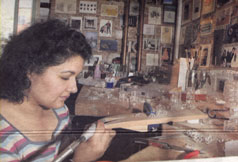 ASHI HAS DESIGNS ON NATIONAL FAME
ASHI HAS DESIGNS ON NATIONAL FAME
Article taken from Lincolnshire Echo dated 20/09/2006
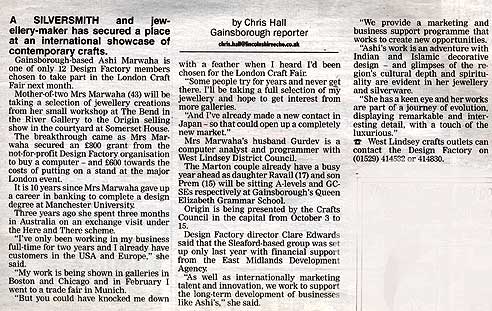
---------------------------------------------------------------------
Knighthood
for Kenya’s leading Film Producer
Kenya’s leading film maker, Mohinder Dhillon, was knighted by the Order of Saint Mary of Zion during a ceremony at the Royal Artillery Headquarters in Woolwich, U.K. on November 12th 2005. Prince Philip is the Order’s Grand Master. The order constitutes a valid chivalric order of knighthood.
“The honours were conferred upon those who had made significant contribution to the society. Honorees included Mohinder Dhillon, whose newsreel photography was viewed to have brought vital issues in the African continent to the attention of the world community. The Award of Knight Commander also recognizes Mr. Dhillon’s professional skills and applauds his efforts, sometimes obtained with considerable risk to his personal safety.”
Also honoured at the ceremony was His Royal Highness Prince Karl Wladimir of Yugoslavia, Grandmaster of the Order of Saint John, which supports humanitarian projects in Yugoslavia
Mohinder had the first indication by e-mail from Professor Frederick Trowman, the Grand Chancellor of the Imperial Order of Saint Mary of Zion on October 19th 2005 in which he invited Mohinder to accept admission into the Order. This is in recognition of Mohinder’s humanitarian assistance to the people of Ethiopia. His films of Ethiopian famine finally moved the world into action resulting in one of the biggest famine relief operations in history. Relief planes from dozens of countries descended on little dirt air strips of Ethiopian countryside round the clock as if they were Heathrow or JFK airports. The very first pictures of the terrible Ethiopian famine which shocked the world was the combined effort of Mohinder Dhillon and Michael Buerk of BBC TV to gain entry into tightly controlled military ruled Ethiopia in 1984 opening the door for rest of the media and rest of the world. The combination of Mohinder’s sensitive images and Buerks well written words somberly delivered raised the alarm of compassion. Buerk/Dhillon TV team jointly produced a series of appeals and a shocking news item that resulted in a miracle response from the viewers and donation rained from the skies very soon amounting to Sterling Pounds 10 million.
Mohinder has a lot to say about the way the children of Ethiopia suffered through no fault of theirs. Over the years Mohinder affectionately known as Mo has made a lot of sponsorship appeals working with Hollywood stars on behalf of children all over the world, drawing attention to the desperate plight of children of Africa and the rest of the world, including the Far East.
Mo admits that he suffers emotionally himself by being continuously exposed to the dire poverty and never ending sufferance where children are dying like flies with parents crying their eyes out. Mo sometimes did not feel eating himself out of guilt conscience and during the night recalling day’s images of children with death in their eyes haunted him. Being devoted to the humanitarian cause, he carried on shooting continuously knowing his films would make a difference in improving the plight of innocent children, putting aside his own personal feelings.

Mohinder Dhillon
Mo is nurturing his old and new injuries which occurred whilst pursuing his profession seriously and fearlessly. His son, Sam Dhillon has more or less fitted into the big shoes of his father and intends to carry on with humanitarian work with the same passion as his father. Mohinder is very proud of Sam’s professional skills plus his personal character, full of compassion and a strong drive to excel. Father & son team run an upcoming company “Africapix Media Ltd”, filming round the world
Mohinder was also invited to ITN (ITV) News to attend their 50th Anniversary Party in September at the Royal Opera House in London where he was an honoured guest having represented ITN mostly in East Africa and Middle East since 1964. He met some old friends he had not seen for over 35 years especially Britain’s Top Rated TV journalist and Presenter of Channel 4 News, Jon Snow. In their heydays the Dhillon/Snow team would never hesitate to risk their neck under any circumstances, and were branded by colleagues as “The Death Wish Team” that would reach great heights, if they stayed alive!!
Mohinder comes from a very humble background, born in a small village in Punjab, India where he obtained junior school education and a bit more at the Duke of Gloucester School, previously Govt Indian High School, Nairobi. Mohinder arrived to Kenya in 1947 as a young boy to follow his father the late Mr. Tek Singh who worked for E.A. Railways and Harbours for 29 years. Mr. Tek Singh was one of the leading pioneers of the sport of hockey in Kenya and was a very active social worker and a highly respected human being. Mohinder’s younger brother Joginder represented Kenya in the first Kenyan Olympic hockey team in Melbourne in 1956. He still plays veteran hockey and is a medical practitioner in U.K, and recognized Sports Doctor helping in events like Olympics and Commonwealth Games. He hopes to bring in a veteran hockey team to Kenya next year to celebrate the 50th Anniversary of the first Kenyan Olympic hockey team.
Read more about Mohinder Dhillon in 'Mo Stories'..Click here
---------------------------------------------------------
DIPLOMATIC APPOINTMENT
for another Ex-Kenyan - Bhupinder Singh Liddar
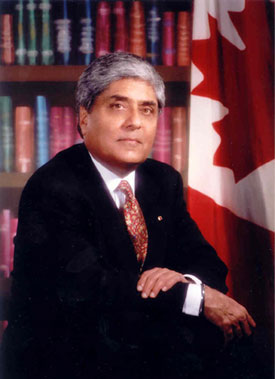
Minister of Foreign Affairs Pierre Pettigrew today announced the appointment of Bhupinder S. Liddar as Deputy Permanent Representative of Canada to the United Nations Environment Programme (UNEP) and to the United Nations Human Settlements Programme (UN-Habitat) in Nairobi, Kenya.
The Deputy Permanent Representative to UNEP represents Canada's views and policies to the Committee of Permanent Representatives, its sub-committees and to the management of the organization. The Deputy Permanent Representative provides strategic and tactical policy analysis and advice on the advancement of Canadian foreign policy and environmental objectives within the UNEP on such issues as conservation of biodiversity, restoring the ozone layer, and water and sanitation for development.
As Deputy Permanent Representative
for UN-Habitat, Mr. Liddar will work to bring an international perspective to
the Government of Canada's preparations for the World Urban Forum, which will
be held in Vancouver next June on the 30th anniversary of the first Habitat conference
in that city in 1976. The Deputy Permanent Representative to UN-Habitat also represents
Canada's views and policies to the Committee of Permanent Representatives, its
sub-committees and to the management of UN-Habitat.
In diplomatic terms, this type of positive outcome is known as a win-win situation.
A former journalist and a well-known personality on Parliament Hill, Bhupinder Liddar, was appointed this week to the High Commission in Kenya where he'll serve as a high level representative to two United Nations' programmes.
Mr. Liddar was thrilled by the announcement which ends a two-year ordeal between him, the department of Foreign Affairs and the Canadian Security Intelligence Service (CSIS).
Former prime minister Jean Chrétien appointed Mr. Liddar in 2003 as the consul-general to a new mission in Chandigarh, India. Mr. Liddar sold his diplomatic publication, gave up his TV show, was briefed by departmental officials and fêted by friends, but before he left Canada, the government of Prime Minister Paul Martin cancelled his appointment.
The intelligence agency, CSIS, had rejected Mr. Liddar's application for security clearance. Mr. Liddar challenged that finding by taking his complaint to the civilian oversight body of CSIS.
After a closed door investigation that involved paper evidence and months of oral testimony, the Security Intelligence Review Committee (SIRC) this summer rebuked the decision to deny Mr. Liddar the clearance, saying the CSIS investigation had been flawed. Based on this finding, Deputy Minister of Foreign Affairs Peter Harder granted Mr. Liddar a clearance and the department sat down with Mr. Liddar to negotiate the next steps.
This week, Foreign Affairs issued a press release to confirm Mr. Liddar as the deputy permanent representative of Canada to the UN Environment Programme (UNEP) and the Human Settlements Programme in Nairobi, Kenya's capital.
Mr. Liddar and his friend Meghie Brar will depart Ottawa in mid-December, and his new job begins after the Christmas holiday. Based on the foreign service pay scale, Mr. Liddar's salary of about $120,000 annually is the same rate as that of consul-general.
Mr. Liddar's reaction was one of relief and excitement. Given he was born and schooled in Kenya and speaks Swahili, Mr. Liddar says the deployment is a "homecoming." He also said the job gives him access to an international network of players that few people have the fortune to experience. And importantly, Mr. Liddar said he now has the endorsement of, not one, but two prime ministers.
"Two prime ministers have put faith in me. Prime Minister Chrétien appointed me and then subsequently Prime Minister Martin," he says. "I think the important thing, and this is for everybody in my view, is that as I have moved on and gone through the process and as a result I have a lot of respect for the institutions of Canada and the process. If you want to have a rule of law you must respect the process, and that process has spoken."
Bhupinder remembers his childhood
I remember it very fondly. My father was a medical doctor who had immigrated to Kenya in 1937; of course in those days it was under British colonial rule. [I was] born in Kenya, educated in high school. A big chunk of my soul is there, and Kenya has always been very dear to me. I'm now in the process of looking up some of my old school friends, and I have traced about half a dozen still in Kenya doing very well. I was last there four years ago on a visit for about 10 days. So I think what I can bring in that background could help in improving bilateral relations.
For details see
www.liddar.ca
Congratulations and best of Luck from Sikh Heritage.
Unknown hero of the independence struggle
06/02/2006
Story by ELLY WAMARI /Inside Story taken with courtesy from
http://nationmedia.com/dailynation/nmgcontententry.asp?category_id=27&newsid=74028
On Saturday, May 20, 1950, about 750 railway workers of African decent refused to report for duty.
They had effectively joined a general strike by other sectors in Nairobi, Kisumu and Mombasa, which had been going on for four days as an affront on the colonial administration.
Among the issues that they wanted addressed were "freedom for all workers, and freedom of the East African territories". There had been growing discontent over mistreatment by British authorities.

|
|
Entry of railway workers into the strike was a big boost. It got the British rulers worried. Operations of the railway corporation, particularly the central workshops and the engineering department, were greatly affected, threatening to disrupt an essential service.
What surprised the colonial powers was the little-known young Sikh who led most of the railway workers to the general strike. Jarnail Singh Liddar was only 20 years old then, but he convinced his colleagues to join the mass action.
On May 19, Jarnail went to the corporation's central workshops and gave a key talk. He told the workers to join the strike that had started on May 16, a day after the arrest of two pioneer trade unionists and political activists, Makhan Singh and Fred Kubai.
The strike demanded release of the two, as well as of Chege Kibachia, another trade unionist.
Railway workers had generally stayed out of the strike. But young Jarnail, figuring that involvement of this large volume of workers would pinch the colonial administration where it hurt most, decided to woo them.
Angered by the arrest of his mentors, Jarnail had resigned his job with the Post Office on May 17 to play a prominent role in trade unionism. The absence of Makhan and Kubai begun to be felt. Confusion emerged after some people argued that the strike was unlawful.
Makhan and Kubai were arrested in the early hours of May 15 at their respective houses in Park Road and Pumwani. They were charged with being officials of an "unregistered trade union" – namely the East African Trade Unions Congress.
British authorities had noted that the workers' strikes that Makhan, Kubai and Bildad Kaggia had organised earlier in the month (May 1) to boycott Labour Day celebrations were more political than industrial. The leaders had to be tamed.
Little did the authorities know that a young Sikh would spring up from the background and command enough authority to sustain the insurgency.
Jarnail's first stop – two days after he resigned the Post Office job – was the railways central workshops. The youthful six-footer got the attention of workers there. He told them of the importance of joining the strike.
The effect of his speech was reckoned with the next day. The specific time of his talk is not documented, but it was in the morning. By lunch hour, he had moved to Shauri Moyo, the centre of trade union activities then, for his next talk.
The Shauri Moyo address rejuvenated an ebbing morale among the workers to sustain the strike. A day earlier (May 18), police had battered workers in an attempt to split them up and break the strike. On the third day, workers were beginning to tire. Jarnail did not want that to happen.
His talk dwelt on the need for people to be solid in their stand. He pointed out that he had urged railway workers to join the revolt.
With that, he lifted the spirits of the masses. Railway workers joined the strike the next day. Word spread quickly to other towns in Kenya and the roll over effect drove the colonial administration back to the drawing board.
Although newspaper reports downplayed the workers rebellion, the May 20 boost is recognised in Makhan's book (The history of Kenya's trade union movement to 1952) as one of the most elaborate insurgencies against the British administration.
What had been reported in newspapers as a Nairobi affair spiralled to other towns in Kenya – mostly Mombasa, Kisumu and Nakuru.
Unfortunately, Jarnail did not get a moment to relish his success. Events of May 20 and the five days that followed found him behind bars. He had become a threat to the colonial administration.
The political undertone of Jarnail's talks as he urged workers to continue calling for an end to widespread discrimination against non-British people worried the administration.
As soon as he was through with his fiery speech at Shauri Moyo on May 19, Jarnail was picked by police and charged with "inciting a strike in an essential service", meaning the railways.
He had been scheduled to give another speech at 4pm that day, but that was not to be. He was arrested as he walked out of Shauri Moyo. But he had made his point.
Jarnail was sentenced to six months of hard labour. Thereafter, he was kept on the periphery of political activism – which was mostly channelled through trade unionism.
It is no wonder that little is said about him during talks on madaraka and uhuru heroes. And not much is written about him, also. A large section of today's Sikh community learnt of Jarnail's exploits after he died in August 1997, when a temple leader told of his political life in the pre-independence era, during a memorial service.
The British had noted a charisma in Jarnail that would pose problems to the system. When Jarnail travelled back to India soon after his release to pursue marriage, the administration declared him a "prohibited immigrant". They vowed not to allow him back lest he caused more trouble.
When Jarnail attempted to return to Kenya on January 26, 1953, he was denied entry and informed that he was unwanted. His re-entry pass, as indicated in his then passport number A41108, was cancelled by immigration officers. He was sent back to Bombay, India, where, as indicated in his passport, he landed on January 29, 1953. That marked the end of his direct involvement in Kenya's pre-colonial activism.
The administration had been wary of his emerging ability to instigate mass action, and would not give him another opportunity. They locked him out of the country, yet his father, Dr Jodh Singh Liddar, and younger step-brother, Bhupinder Singh Liddar, were Kenyan residents.
Ten years later, in October 1963, Jarnail was able to return to Kenya on the invitation of Jomo Kenyatta. This followed the withdrawal of his travel restrictions after the country attained self-governance (madaraka) on June 1, that year.
Jarnail's childhood friend, Amarjit Singh Gataure, now 75, says Kenyatta had a soft spot for Jarnail. When the prohibitions were lifted, Jarnail was encouraged to return to Kenya. Amarjit remembers Jarnail as a youth who could put everything on the line to support a worthy cause.
Still, after he came back, Jarnail made a spirited campaign to get Kenyan citizenship ... and that frustrated him. He felt that his earlier efforts had not been appreciated.
On September 29, 1965, he wrote: "... Now, after lifting the ban, I have been allowed to return on an employment pass. This has not solved my basic difficulties and falls much short of my requirements and fundamental rights. Therefore, my humble prayer is that I, being a loyal citizen, my request should be given a sympathetic consideration and I should be granted citizenship of Kenya.
"It was for purely political activities which were then desirable and necessary in the interest of national struggle, that the colonial government threw me out of the country..." The letter was addressed to the Minister for Home Affairs.
But he got no assistance, prompting him to make another appeal in November 1968. That did not yield citizenship to him, either. He again stated his case on October 2, 1969, reminding the Government that it was yet to consider is application. He was finally awarded citizenship on November 14, 1969.
Jarnail is little known because his story has never been fully told. This is partly because he, too, following the frustrations he experienced on returning to an independent Kenya, opted for a low profile.
He kept his family out of the picture. Son Jagjit Singh Liddar, who now lives in the house his father bought in 1973, remembers him only as a tough man out there, but one with a soft spot at home. Says Jagjit: "He did not talk much about his experiences to us. Apparently, he did not want us to get too involved because of him."
Jagjit says his father first arrived in Kenya in 1937 as a minor. He was seven years old then and accompanied his father, Dr Jodh. He grew up in Nairobi and attended the Duke of Gloucester School, now Jamhuri High School.
His interest in socio-political activities became evident soon after he left school. Jarnail's younger step-brother, Bhupinder, talks of him as one who was often in trouble with the colonial authorities because of his anti-oppression stance. Jarnail did not last long as a police officer because of that, for example.
Says Bhupinder: "There was an age-gap between us, but I remember my father coming home several times and saying, 'Jarnail is in trouble, again'."
Their father was then a medical doctor assigned to the police and would use his influence to bail out Jarnail every time he brushed the authorities on the wrong side. The family lived near Kingsway Police Station, which is currently Central Police Station.
There were about five houses between Norfolk Hotel and the police station, recalls Bhupinder. "We lived in one of them, but Jarnail spent a lot of time away from the house. He was mostly with Makhan, learning the ropes of trade unionism and political activism. At other times he was in Shauri Moyo attending to union matters."
Makhan was an established activist against the colonial regime. By associating with him, Jarnail met and befriended Kubai and Kaggia. He was deeply involved in unionism, albeit in the background. "Makhan was his mentor," says Bhupinder.
The May 1950 strike involved about 100,000 workers. It ended on May 25 after the authorities unleashed the military and arrested about 300 workers, most of whom were detained. But the strike helped workers realise that they had the power to hasten the country's uhuru.
Mass action continued in later years. In 1952, the British administration came up with a Trade Unions Ordinance to muzzle workers. A State of Emergency was declared. Those agitating for independence were arrested and detained.
-----------------------------------------------------------------------------------
PUNJABI HERITAGE IN EAST AFRICA
The history of the South Asians in East Africa is not very old. It is only about 100 years since the first Indians landed on the shores of Kenya, namely Mombasa. The journeys in those days were accomplished in dhows which were the main source of transport and starting from Bombay the journeys could take as much as months to complete as the dhows depended on the state of the winds. It was after a lot of hardships that some of our ancestors reached Kenya to serve in the Uganda Railways which was being built from Mombasa to Kampala.
The Punjabis (Hindus, Muslims & Sikhs) were the main source of skilled and semi skilled labourers who worked on the railways. They suffered numerous hardships including the lions of Tsavo.
Do You or Your parents or Grandparents had any escapades, adventures, memorable incidents, interesting stories, their rise to fame or riches, old photographs or mementoes, souvenirs, brochures of Kenya, Uganda, Tanganyika - magazines printed by gurdwaras or federations, clubs, schools, students etc. Any documents or photos about East Africa – anything!
I am in the process of writing a book on the ‘Punjabi Heritage in East Africa’ and I need information as much as possible. Just get in touch with me and send me the information (which will be returned after use). Your name will be acknowledged in the book.
Your assistance would help in inserting your ancestors’ names in the history of East Africa.
Kindly contact,
Harjinder Singh Kanwal,
20 Trewint Close,
Exhall,
Coventry CV7 9FG
U.K.
Phone: 024 7631 9483
E/mail: harjinder@kanwal99.freeserve.co.uk